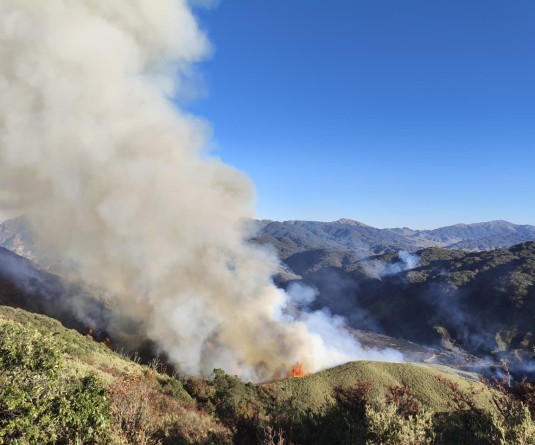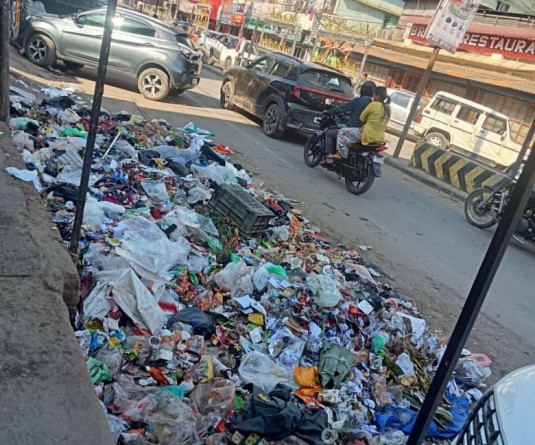Panellists at the Penguin White Owl Literature Festival & Book Fair at Zone Niathu by The Park, Chümoukedima, on February 18.
.jpg)
Conversation on Writing about the Indo-Myanmar Borderland explores diverse perspectives
Morung Express News
Chümoukedima | February 18
How does one locate Northeast India—a region that is complex, contentious, yet deeply connected? This was a key focus of the panel discussion titled, “Frontiers, Corridors, and Connectivities: A Conversation on Writing about the Indo-Myanmar Borderland,” at the ongoing Penguin White Owl Literature Festival & Book Fair at Zone Niathu by The Park, Chümoukedima, on February 18.
Is the Northeast really a frontier or a corridor, and how does one look at its connectivity? Moderator Golan Naulak kicked off the session, stressing that although the region shares over a 1,600-kilometer international border with Myanmar, there seems to be very little writing about it.
The panel featured Sanjoy Hazarika, journalist and author; Patricia Mukhim, activist and journalist; Mhon Kikon, academic and writer; and Samuel G Ngaihte, academic and author, and revolved around the concept of “borders,” their historical construction, and their real-world implications for the communities living in these frontier regions.
Hazarika responded by highlighting the “ad-hoc” policy towards Myanmar, stating that it remains largely security-driven, with China perceived as the primary adversary. He argued that this narrow approach disregards the complexities of Myanmar and Northeast India, and the shortcomings of the “Look East/Act East” policy, which struggles to be effective amid instability in neighboring regions.
Hazarika, however, also attributed the lack of academic focus to restricted access and a perception that these areas are less significant compared to other frontier regions.
Likewise, sharing her experiences of visiting border areas and witnessing the disconnect between official policies and ground realities, Mukhim remarked on the paradox of “hard borders,” where physical barriers remain incomplete while daily cross-border interactions persist. She stressed that Northeast India shares only a small percentage of its borders with the rest of the country, with the majority bordering other nations.
To this end, Mukhim questioned why the government prioritizes internal security over external relations, particularly with Myanmar, citing the long-delayed Kaladan Multimodal Project as a case of ineffective diplomacy and unclear strategic objectives. She urged policymakers to engage directly with border communities to understand their lived experiences.
Giving a historical perspective, Kikon, a former legislator of the Nagaland Assembly, cited how the British colonial administration framed the Northeast as a “frontier” while disregarding existing local structures and relationships. He discussed how colonial legacies continue to shape contemporary policies, including the Free Movement Regime (FMR).
Kikon also touched upon the complexities of Naga identity and cross-border solidarity, noting that much of Naga literature has historically centered on the political movement. However, he noted that policies like the FMR should be viewed within broader geopolitical changes and security imperatives.
He also pointed out that policies like the FMR were created to ensure that, at least around the region where there are familial and ethnic relations, people-to-people relations, especially in terms of cultural celebrations and all that, are encouraged and supported by the government.
Kikon also pointed to the fluidity of policy as evident in how border-related decisions have played out over time. The proposal for border fencing, initially suggested by the Congress government around 2004, received reactions similar to those seen in response to the recent announcement, he said. This highlights how policy dynamics are often anchored in the past rather than adapting to evolving circumstances, he argued. Kikon also pointed out that Arunachal Pradesh, which shares the longest stretch of the Indo-Myanmar border, also requires greater attention in border discussions.
Meanwhile, Ngaihte challenged the state-centric discourse surrounding borderlands by arguing that the term “border” itself is a construct imposed by the state and does not reflect the lived realities of the people inhabiting these regions. Instead, he described them as “inhabited spaces” with histories of movement, trade, and cultural exchanges.
He also lamented the lack of academic frameworks and terminology that adequately capture these realities, stating that existing paradigms like post-colonial and subaltern studies remain insufficient. To this end, Ngaihte stressed the need to adopt local terminologies and perspectives.
He also highlighted the role of oral traditions as primary sources for understanding the region’s history and culture, pointing out that the Zo people, spread across multiple post-colonial states, continue to observe traditional rituals that require them to cross borders, underscoring the importance of non-state practices and cross-border kinship networks.
Hazarika also acknowledged the significance of oral histories and local knowledge in shaping a more accurate narrative.
As the discussion progressed, the panelists called for a shift in narratives surrounding the Indo-Myanmar borderlands.
Mukhim advocated moving away from militarised perceptions and instead focusing on economic opportunities and regional cooperation.
She urged policymakers to rethink the Act East framework by factoring in the diverse challenges posed by instability in Myanmar and Bangladesh. She also the reliance on seminars and workshops held in Delhi, far removed from the actual stakeholders.




.jpg)

